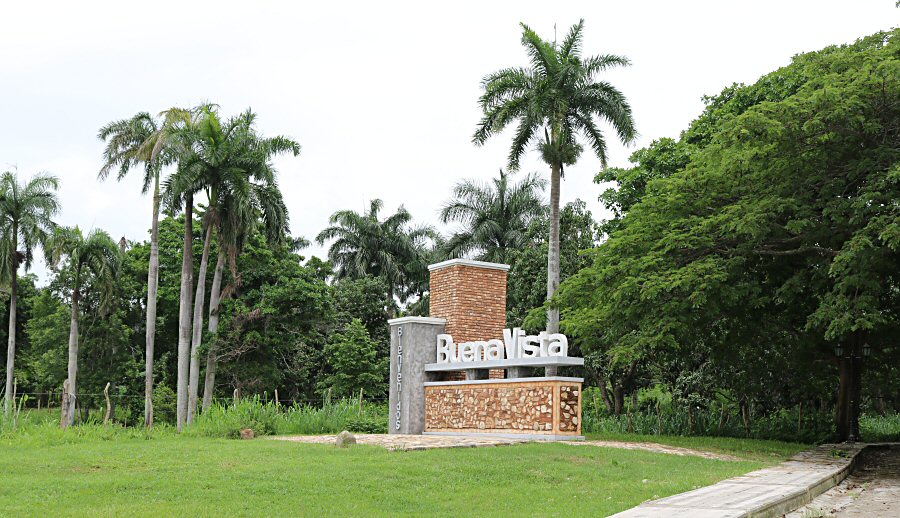Localization
The hacienda of Buena Vista is about 9,5 km north of Trinidad, on the road to Sancti Spiritus.

INGENIO BUENA VISTA
Little remains of what was once the Ingenio Jesús de Nazareno de Buena Vista. The stately mansion has been restored and converted into a hotel and restaurant.
History
It is estimated that the Buena Vista sugar mill, formerly called as Ingenio Jesús Nazarenos de Buena Vista, was founded in 1740s on the lands of the Cuyují (Cullují) and Manacanacú community. The hacienda occupied an area of about 48.000 m2. The land had a beautiful view and was in the neighborhood of Río de Ay (current Alabama River). It was bordered by the road to Caracusey to the north, by the Santo Cristo de los Destiladeras and San José de la Cruz sugar mills to the south, by the Aracas-Marín pasture to the east, and the San Isidro de los Destiladeros sugar mill to the west.
In 1747, his owner Lucas Zamora registered the sugar mill as “a trapiche for making honey and sugar”. Trapiche means a mill to extract the juice of some agricultural products such as olives or sugar cane in Spanish. In 1780, the Jesús Nazarenos de Buena Vista sugar mill began to be talked about. His owner was Juan Nepomuceno Fernández de Lara. In 1794 the hacienda belonged to Manuel Antonio Fernández de Lara y Alfonso del Manzano, and in 1803 it passed into the hands of Pedro Malibrán.
It was Pedro Malibrán who converted the sugar mill into the second largest sugar mill in the country, after the Guáimaro sugar mill in 1828. His sugar mill was producing good quality white sugar. Also, he made the Buena Vista sugar mill the pioneer in the reuse of waste bagasse as fuel. In the 1830s, the surveyor Francisco Lavallé made a topographical plan of the place which includes not only the house, but also the entire land, which is of incalculable historical value, as it gives exact location of this hacienda, and the slave huts. At this plan, 32 slave huts, built of masonry and tiles, and located in an orderly manner at the foot of the hill, can be perfectly observed.
Pedro Malibrán sold the hacienda to his son Carlos Malibrán for 451,886 pesos shortly before his death in 1837. At that date 320 slaves were working in the hacienda. Except for the beautiful dwelling house, hacienda's inventory was endless: steam mill, oxen train, pan trains, 27 yoked wagons, 492 oxen, 63 calving cows, 42 horses, 17 horses, 16 mares and 26 mules.
The new owner Carlos Malibrán made radical changes to the dwelling house, bringing it closer to the Roman neoclassical style.
In 1845, Carlos Malibrán made an agreement with Justo Germán Cantero and exchanged his Buena Vista sugar mill with another sugar mill called La Caridad. Justo Germán was the owner of the Buena Vista, Guinia de Soto and La Caridad sugar mills.
Little remains of what was once the Ingenio Jesús de Nazareno de Buena Vista. The stately mansion has been restored and converted into a hotel and restaurant.
History
It is estimated that the Buena Vista sugar mill, formerly called as Ingenio Jesús Nazarenos de Buena Vista, was founded in 1740s on the lands of the Cuyují (Cullují) and Manacanacú community. The hacienda occupied an area of about 48.000 m2. The land had a beautiful view and was in the neighborhood of Río de Ay (current Alabama River). It was bordered by the road to Caracusey to the north, by the Santo Cristo de los Destiladeras and San José de la Cruz sugar mills to the south, by the Aracas-Marín pasture to the east, and the San Isidro de los Destiladeros sugar mill to the west.
In 1747, his owner Lucas Zamora registered the sugar mill as “a trapiche for making honey and sugar”. Trapiche means a mill to extract the juice of some agricultural products such as olives or sugar cane in Spanish. In 1780, the Jesús Nazarenos de Buena Vista sugar mill began to be talked about. His owner was Juan Nepomuceno Fernández de Lara. In 1794 the hacienda belonged to Manuel Antonio Fernández de Lara y Alfonso del Manzano, and in 1803 it passed into the hands of Pedro Malibrán.
It was Pedro Malibrán who converted the sugar mill into the second largest sugar mill in the country, after the Guáimaro sugar mill in 1828. His sugar mill was producing good quality white sugar. Also, he made the Buena Vista sugar mill the pioneer in the reuse of waste bagasse as fuel. In the 1830s, the surveyor Francisco Lavallé made a topographical plan of the place which includes not only the house, but also the entire land, which is of incalculable historical value, as it gives exact location of this hacienda, and the slave huts. At this plan, 32 slave huts, built of masonry and tiles, and located in an orderly manner at the foot of the hill, can be perfectly observed.
Pedro Malibrán sold the hacienda to his son Carlos Malibrán for 451,886 pesos shortly before his death in 1837. At that date 320 slaves were working in the hacienda. Except for the beautiful dwelling house, hacienda's inventory was endless: steam mill, oxen train, pan trains, 27 yoked wagons, 492 oxen, 63 calving cows, 42 horses, 17 horses, 16 mares and 26 mules.
The new owner Carlos Malibrán made radical changes to the dwelling house, bringing it closer to the Roman neoclassical style.
In 1845, Carlos Malibrán made an agreement with Justo Germán Cantero and exchanged his Buena Vista sugar mill with another sugar mill called La Caridad. Justo Germán was the owner of the Buena Vista, Guinia de Soto and La Caridad sugar mills.